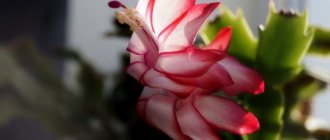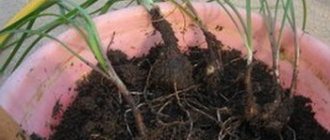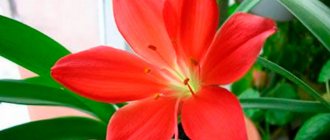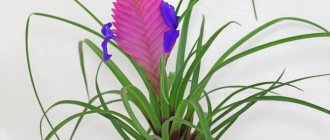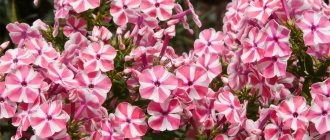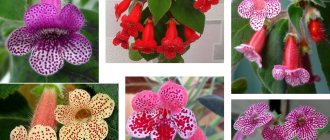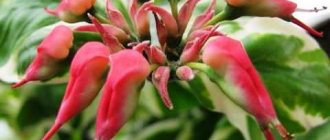Reo is an indoor plant, up to 50 centimeters high, with a small creeping trunk, on which is attached a rosette with oval, elongated leaves, smooth and green on top, and velvety and purple below, the length of the leaves is from 25 to 30 centimeters. Often this indoor plant is classified as one of the types of Tradescantia, although this is a controversial issue. Reo is actually a close relative of zebrina and tradescantia, all of which belong to the Commelinaceae family. But some botanists believe, and this would be more correct, that such a flower forms its own separate genus, Reo.
Description of the flower
Reo is a herbaceous plant native to the tropical forests of South America. It is distinguished by its dense leaves, which reach up to 30 cm in length. They come in purple, green or striped. In mid-July, the plant produces white flowers.
Reo, or as gardeners like to call it, Tradescantia variegated, is an attractive houseplant from the Commelinaceae family. The flower is found mainly on the edges of the tropics; it likes to grow near rivers and lakes, which indicates its endurance. Reo is as unpretentious as a cactus, but as beautiful as an orchid. Therefore, it is ideal for beginners.
The stem of the flower is thick and dense, standing straight. It grows up to 30-40 cm in height, its leaves grow in different directions, and the shape of the plant is always different.
Houseplants with purple spots or stripes on leaves
Home flower with maple-like leaves - striped abutilon
Indoor flowers that have a heterogeneous color look very impressive: with spots or stripes, a marble shade. The most attractive of them:
- royal begonia. This is one of the leafy begonia hybrids, grown not to admire the lush inflorescences, but to enjoy the foliage of an unusual, spotted color all year round. The leaf part has an asymmetrical shape and reaches a length of up to 15 cm. The pattern is always bright, representing a complex pattern of green, purple, silver and burgundy colors. Royal begonia is a very fastidious plant that needs extra attention;
Royal begonia
- Zebra Purpusa. One of five types of zebrina suitable for growing at home. The leaves are oval-shaped with pointed edges and a pronounced striped color. The colors of the stripes are white with lilac-burgundy, which looks very unusual and attractive. Blooms with small lavender flowers;
- irezine Linden. This is a plant whose leaves are dark purple on top, with reddish stripes and veins.
Iresine Lindena
Home care
Reo is an unpretentious and beautiful indoor plant, but you need to remember a few rules in order to successfully care for it. The plant loves light; a south window is the best place for it. But in the summer heat, Reo still needs to be shaded a little, otherwise the leaves will suffer from the sun's rays.
Reo flower is poisonous! When working with this flower, you must be careful, as the juice of this tradescantia is poisonous. It is irritating to the skin and can cause contact dermatitis.
Lighting
The flower loves diffused sunlight, just like in its natural environment, in the tropics. Therefore, it is better to place it on a window facing east or west. The natural light he will receive will be quite enough. On the south side you need to create a little shade, the north side is undesirable: the leaves lose color and the stems become very elongated.
Temperature
Reo variegated prefers moderate temperatures, 20-24 degrees Celsius is ideal. However, if the temperature is higher, the flowers can easily tolerate it. Temperatures below 15 degrees Celsius are undesirable for the plant.
Humidity
Of course, for the variegated rheo, the ideal option would be a humidity of more than 70%, again as in a natural tropical environment. During the heating season, regularly humidify the air; you can place a flower pot in a special tray with wet pebbles, where you should regularly add water. If you do not maintain the required level of humidity for Reo variegated, the leaves may dry out.
Watering
The plant loves abundant watering, so it needs to be provided regularly. It is better to use softened water at room temperature; in winter, reo likes water a little warmer.
The flower likes constantly moist soil, so it’s not scary if someone mistakenly waters it again. Handsome Reo grows remarkably well when the ground is always wet during the warm season. But in winter you need to be more careful with watering, you need to reduce it a little, but there should not be drying out. It is advisable to water with settled water; rain water is even better for this. In winter, the flower should be watered with warm water. And yet, the flower really doesn’t like it when water gets into the places on the stem where the leaves are attached (the internode), you need to try to prevent this from happening.
The flower develops well if it is sprayed regularly. A summer shower is a great way to keep your flower toned and clean.
Top dressing
Flowers need to be fed a couple of times a month with the usual universal fertilizer, which is used for decorative deciduous plants. In winter, reo motley does not need feeding.
How to pinch
Reo has a dense, upright and gnarled stem, from which multi-colored leaves and a well-developed rhizome stretch upward in different directions. To form bushiness, the upper shoots and trunk are pinched, and then the rheo thanks the owners with a lush cap that covers the pot and extends beyond it. To make the plant look more impressive, different varieties are mixed when planted in one pot. As a result, you get not only a luxurious bush, but also a natural composition that is captivating with its varied colors.
Trimming
The lower leaves of the reo can be trimmed periodically, but it is still better to re-grow the plant every few years. Faded inflorescences should be cut or pinched off.
Transfer
Young variegated rheo needs annual replanting into larger, wider, but shallow pots, because the root system of the flower grows in breadth.
The soil
The plant prefers a light and nutritious substrate with an acidity of 5.5 pH to 6.5 pH. It is worth making a special drainage layer at the bottom of the pot.
Transfer
As a rule, the flower grows as a bush and young shoots constantly appear at the base of the bush, so it simply needs replanting every year. For this, it is better to use wide pots, given the fact that the flower grows wider. The substrate can be purchased ready-made or prepared independently from the following components:
- 1 part clay-turf soil.
- 1 part leaf soil.
- 1 part peat.
- 1 part humus.
- 1 part sand.
Considering that the plant loves abundant watering, it is necessary to provide it with powerful drainage, without which it is better not to plant the flower, as it will fester or the roots will be affected by root mites.
But no matter how simple the care may seem, problems in the development of the flower can still be observed. This can happen when the one who has this flower growing simply forgets about it, which is unacceptable. If such problems are detected, you should look for the cause and try to neutralize it.
Where and how does it grow
Under natural conditions, the flower can be seen on the American and African continents. There, Tradescantia reo grows as lush shrubs on mountain slopes or in moist soils.
The reo flower (photo in the wild) looks like a real holly thicket. The total height of the plant reaches half a meter. Over time, the lower leaves fall off the trunk, and Tradescantia begins to resemble a miniature lilac-green palm tree.
Reproduction
The flower is easily propagated using cuttings or side shoots; the roots form well not only in the soil, but also in an ordinary container with water. Reo can be propagated either by seed or by apical or lateral cuttings. With the vegetative method of propagation, in the spring the selected cuttings are carefully (with a disinfected and sharp knife) separated from the main plant and planted in separate containers with a sand-peat mixture, moistened and placed in a room with an air temperature of about twenty degrees. Cuttings also root very easily in water with the addition of a growth stimulator. To prevent rotting, the lower leaves are removed from the cuttings . After the roots appear, the shoots are transplanted into pots.
Adult flowers can always be divided:
- into 2-3 parts, simultaneously rejuvenating the plant and reducing the size of the growing container;
- separate individual side shoots, which quickly take root and begin to grow in separate pots.
Usually, division, rather than cuttings, is chosen when growing in ampels, because the volume of containers is limited and with constant growth the rheo becomes too heavy.
Sowing seeds should be done in mid-spring in boxes with peat and sand. Plantings need to be moistened and covered with polyethylene film. Spraying and airing of crops should be carried out daily. The seeds germinate easily and quickly, and the seedlings grow quickly. But at the same time, you need to remember that only plants with green foliage can be propagated in this way, since decorative characteristics are not preserved in this case.
Varieties - photo
The following varieties of reo are most suitable for cultivation indoors:
Reo discolor Vittata is a short representative of the genus with bright, yellow stripes on the leaves;
Reo discolor Compacta is a violet-green specimen with excellent bushiness;
Reo discolor Stripe in Pink is a very beautiful flower with an original color: the purple surface of the leaves is decorated with pink stripes on the upper side and the same, but with a purple tint, on the back side of the leaf.
Plant variety
For a long time, it was customary to grow only one type of flower - the capillary one. But modern selection offers a wide selection of Reo varieties, for every taste and color. Traditionally, Reo leaves have a two-color color - green-violet.
The flowering process can occur at any time of the year. The primordia of the inflorescence arise in the axils of the leaves in the form of small white flowers, which are wrapped in a bract.
Diseases and pests
Reo is rarely affected by diseases and pests. But if not cared for properly, a scale insect may appear on it, which needs to be washed off with a soap solution, and then the plant is completely treated with an insecticide. Infection with rot or powdery mildew may also occur. In this case, you need to remove all damaged parts of the plant, and spray the remaining parts with a fungicide solution. If these measures do not give the desired result, you need to destroy the infected plant.
First, the tips of the leaves change color to brown and then dry out.
The main reason for this problem is too dry air in the room. As a rule, dry air is formed in winter, after turning on the heating system. In this case, the plant needs to be sprayed more often, and in addition, place a bucket of water near it.
The tips of the leaves begin to turn brown, and then curl and begin to dry out.
This may indicate that the plant is not sufficiently watered and watered with sufficiently cold water. For watering, you should use only warm water and well-settled water, then everything will be fine.
The flower begins to stretch out, there are fewer leaves on it
The reason for this may be lack of lighting or lack of microelements.
Variegated species begin to lose their contrasting color, as a result of which the longitudinal stripes become difficult to distinguish
This effect can occur as a result of excessive lighting. In this case, the reo can be moved to a more shaded place.
The stems become cottony (soft) and their color changes to brown
This occurs from excess moisture in winter. The best way to preserve the flower in this case is replanting. To do this, you need to cut off a healthy shoot and try to root it in the ground or in water. If there is a threat of death of the flower, then this procedure can be carried out at any time of the year.
How to avoid the consequences predicted in signs
Superstitions say that in order for a flower not to harm your home and others, you should not wish harm to others. The magical plant easily recognizes the inner mood and directs negative energy back. Before starting a reo, they tune in to the positive and reconcile with their enemies, and an amazing flower will help to improve relations further.
According to superstition, only a healthy flower can protect a house. Rheo itself rarely gets sick, but due to improper care it is affected by root rot and powdery mildew. If the plant is overwatered, the substrate must be dried or completely replaced. During transplantation, rotten areas are removed, and the cut is treated with crushed coal or ash.
Important! Rheo does not always get sick from improper care. Superstitions around it say that, in this way, the flower protects its owner from damage, taking on all the negativity.
Signs
Reo's leaves, which have a double color, suggest that there is some kind of mystery hidden in them.
- Indeed, if you have a reo flower in your home, it can have a double effect on those living: it increases the creative activity of those who possess it, and reduces the level of tension and aggression that can periodically arise in relationships.
- The plant has a beneficial effect on everyone who is engaged in any useful work: its energy encourages creativity and forces you to finish what you start.
- The reo flower normalizes the atmosphere in the house, neutralizing negative energies and increasing the level of positive vibrations; signs indicate that the presence of this indoor plant in the house increases the vital activity of household members, helps to organize thoughts, give them a positive direction, and develops creative thought and imagination.
The plant gives its owner eloquence and the ability to think logically. The reo flower, as evidenced by signs and superstitions, is able to protect against witchcraft and curses, and keeps the residents of the house from bad deeds, makes them think about the consequences of rash actions, and also clears thoughts of negativity.
Signs depending on the type of Tradescantia
Each plant species is unique. They differ from each other not only in color, leaf shape and size, but also in their ability to influence their owner. Let's look at the most common types and their properties:
- Virginian energizes with optimism, gives a good mood and calms thanks to its bright pink or purple buds;
- Blossfeld gives a person self-confidence, promotes well-being in the family, and helps move up the career ladder;
- zebrina is a real home amulet, protects against the evil eye and ill-wishers, and prevents bad events from happening to family members;
- Anderson - a symbol of good mood, calm and harmony in family life;
- Setcreasia purple absorbs the surrounding negativity, but when filled to the limit, it reflects it into the atmosphere, provoking minor troubles and omissions between people.
IMPORTANT! In order for Tradescantia to have a positive effect on people, it is necessary to treat it with care and properly care for it.

